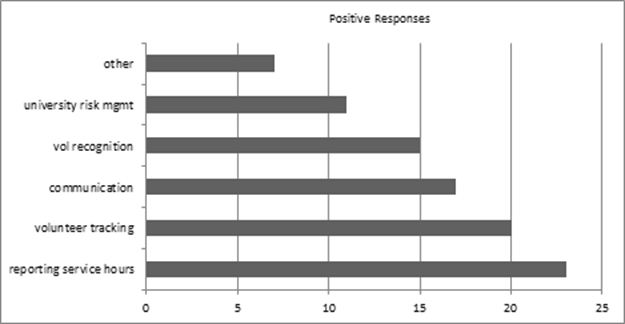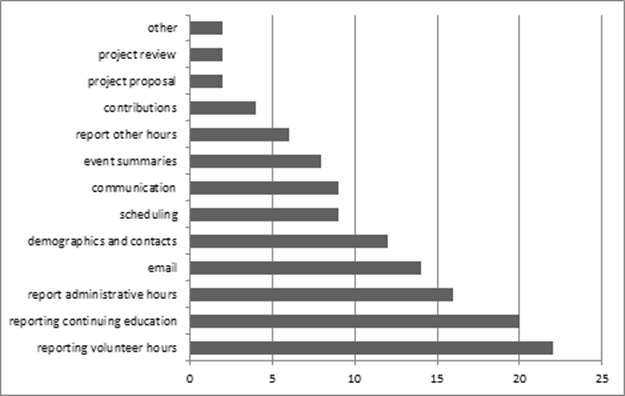 |
August 2016
|
August 2016 // Volume 54 // Number 4 // Tools of the Trade // v54-4tt8
A Review of Extension Master Gardener Program Record-Keeping Systems
Abstract
Record-keeping systems (or volunteer management systems) were identified as a capacity-building tool for Extension master gardener volunteer (EMGV) programs. Not all states have or use such systems, and there are differences among existing systems. A survey was conducted in June 2015 to document and compare record-keeping systems for EMGV programs nationally. Survey results indicate that EMGV programs are still hours-focused in reporting and data collection and that EMGV record-keeping systems offer time-saving benefits for state coordinators, agents, and volunteers. Record-keeping systems also offer potential for further engaging Extension master gardeners in Extension outreach and demonstrating educational impact in communities.
Introduction
Volunteers are essential to Extension outreach (Boyd, 2004), and Extension master gardener volunteer (EMGV) programs are key to effective dissemination of horticultural information to the public (Bauske et al., 2011). Being able to document volunteer contributions strengthens Extension partnerships with volunteers. Data systems can capture the power of volunteers, documenting the ongoing contributions that volunteers make to Extension (Nippolt, Pleskac, Schwartz, & Swanson, 2012).
Record-keeping systems (or volunteer management systems) were identified as a capacity-building tool for EMGV programs (Bauske et al., 2011). Early systems demonstrated the ability to establish program accountability while also reducing the administrative burden of managing volunteers (Bradley, Cook, & Cook, 2011).
There are benefits to using automated record keeping, including volunteer motivation, program efficiency, and impact reporting (Bradley et al., 2011). Despite advantages of record-keeping systems for EMGV programs, not all states have or use such systems, and there are differences among existing systems. A survey was conducted in June 2015 to document and compare record-keeping systems for EMGV programs nationally.
Results
Extension representatives in 24 states submitted 29 responses. For states from which more than one response was received, only state program administrator responses were used (five responses were excluded). Of the 24 states responding, 20 (83%) reported having a web-based electronic record-keeping (or volunteer management) system. Also, 20 systems (83%) allow EMGV access for self-reporting. States have been using electronic systems for as many as 24 years (Figure 1).
Figure 1.
Length of Time Existing EMGV Record-Keeping Systems Have Been Used

System Development, Compatibility, and Integration with Other Systems
The online systems used for EMGV record keeping were designed in-house with university information technology (IT) staff (n = 6, 30%), created for the EMGV program by an outside contractor (n = 7, 35%), or purchased as an existing system (n = 7, 35%). About half (55%) are mobile-friendly (i.e., compatible with mobile devices, smartphones, tablets, etc.). Additionally, 17 responders reported that their respective universities use online systems for other data, such as contacts reporting and 4-H data. However, only one state reported that the EMGV record-keeping system (designed with university IT staff) integrated with other university reporting systems. Table 1 shows data related to system development, compatibility, and integration with other systems.
| Does your state use a web-based, electronic record-keeping (or volunteer management) system in conjunction with the EMGV program? | Is your record-keeping system site mobile friendly? | Does your EMGV record-keeping system integrate (share data with) other reporting systems at your university? | |||
| Development status of record-keeping system | Yes | Yes | No | Yes | No |
| We designed our own system with university IT staff. | 6 | 4 | 2 | 1 | 5 |
| We hired someone to create a system for us. | 7 | 5 | 2 | 0 | 7 |
| We bought an existing system. | 7 | 2 | 5 | 0 | 7 |
| We are considering purchasing or developing a system. | 2 | ||||
Purposes
The primary purpose of EMGV record-keeping systems is to report volunteer service hours (Figure 2).
Figure 2.
Purposes of EMGV Record-Keeping Systems

Use by EMGVs
EMGVs are introduced to record-keeping systems primarily during basic training (75%) and receive assistance with the systems through written directions/handbooks (58%) and special training (58%). Online videos and webinars are also used. More than half of the respondents (58%) indicated that EMGVs are introduced to their record-keeping systems independently.
An estimated 73% of EMGVs regularly and consistently self-report via the applicable online record-keeping system, 11% of EMGVs never report hours in the system, and 21% of EMGVs (including those in two states that do not currently have an online system) continue to use paper log sheets for reporting volunteer service.
Deadlines have been the primary approach used to get EMGVs to use record-keeping systems (n = 12). Built into EMGV program standards is the expectation that volunteers will engage in a minimum number of volunteer service and training hours annually to maintain active status. If this annual minimum is not met, the individual is not considered an active Extension master gardener. Awards are also used to encourage reporting (n = 9), and representatives from a few states indicated that competition is used (n = 4). Positive incentives that are not used or are rarely used to encourage EMGVs to report via record-keeping systems include prizes (n = 0) and promotional products (n = 1).
Costs
In general, states that created their systems in-house with university IT staff reported lower costs to get started. Systems created by an outside contractor ranged in cost from $0 to $10,000. When existing systems were purchased, prices ranged from $2,001 to more than $10,000. Maintenance of EMGV record-keeping systems involves a combination of in-house IT staff services, state EMGV program personnel time, and external contracted services. Cost-related data are presented in Tables 2 and 3.
| Development status of record-keeping system | What was the original cost to create or purchase your state's EMGV record-keeping system?a | ||||
| $0–$2,000 | $2,001–$5,000 | $5,001–7,000 | $7,001–$10,000 | More than $10,000 | |
| We designed our own system with university IT staff. | 4 | 1 | 0 | 0 | 0 |
| We hired someone to create a system for us. | 1 | 2 | 1 | 2 | 0 |
| We bought an existing system. | 0 | 2 | 1 | 2 | 2 |
| aNot all respondents answered this question. | |||||
| Development status of record-keeping system | What is the cost to maintain your system each year?a | |||||
| In-house IT staff | State EMGV personnel | External contracted services | ||||
| Hours/year | Approximate dollar value | Hours/year | Approximate dollar value | Hours/year | Approximate dollar value | |
| We designed our own system with university IT staff. | 40 | $700 | 20 | $500 | 20 | $600 |
| We hired someone to create a system for us. | 0 | $0 | 145 average (40–250 range) | $1,200 | 13.5 average (10–20+ range) | $1,012 average ($500 to $2,000 range) |
| We bought an existing system. | 0 | $0 | 1,106 | $12,000 average ($3,000–$21,000 range) | 50 | $2,540 average ($1,000 to $3,500 range) |
| aNot all respondents indicated values. In some cases, only one value was reported. When multiple values were reported, average and range are presented. | ||||||
Functions and Features
EMGV record-keeping systems are most commonly used for reporting of volunteer service hours and reporting of continuing education hours (Figure 3). EMGV record-keeping systems also are used to generate various reports (Figure 4).
Figure 3.
Functions of EMGV Record-Keeping Systems

Figure 4.
Reports Generated by EMGV Record-Keeping Systems

Benefits
The most frequently reported benefit of EMGV record-keeping systems is savings of the state coordinator's time (n = 19, 79%). This benefit was followed by savings of agent time (n = 18, 75%) and better data (n = 18, 75%). Improving communication was the least reported benefit (n = 10, 42%), though communication was identified as a leading purpose of record-keeping systems (n = 17, 71%).
Conclusions
Systems created and maintained in-house have the lowest associated costs reported, whereas existing systems purchased have the highest associated costs reported. Universities whose IT staff time is limited or dedicated to other projects may find custom creation of an EMGV record-keeping system a cost-effective strategy. States that have an immediate need for a vetted system may choose to purchase an existing system. Higher maintenance costs of existing systems may come from the process of adapting the system to the particular state's use.
More than half of respondents (58%) indicate that EMGVs are receptive to using online database systems for other functions, with an additional 33% of respondents indicating this as a possibility. This finding bears significance as national committees work to develop impact evaluation models for EMGV programming. To increase the number of EMGVs reporting both volunteer service and programming data via automated systems, agents and coordinators can look to motivators cited for encouraging faculty to blend program evaluation and impact reporting. Franz and McCann (2007) suggested program awards and excellence grants as motivators and further suggested that focusing on good organizational citizens rather than resistors enhances reporting quality.
Though results indicate that EMGV programs are still hours-focused in reporting and data collection, record-keeping systems offer potential for further engaging EMGVs in Extension outreach and demonstrating educational impact in communities. Record-keeping systems can draw EMGVs into project development and reporting by allowing for the collection of data such as project and event summaries and impact data. Automated systems increase the capacity and effectiveness of EMGV programs and offer a means of documenting volunteer efforts and accomplishments that support Extension's educational mission.
References
Bauske, E. M, Kelly, L., Smith, K., Bradley, L., Davis, T., & Bennett, P. (2011). Increasing effectiveness of Cooperative Extension's master gardener volunteers. HortTechnology, 21(2), 150–154.
Boyd, B. L. (2004). Extension agents as administrators of volunteers: Competencies needed for the future. Journal of Extension [online], 42(2) Article 2FEA4. Available at: http://www.joe.org/joe/2004april/a4.php
Bradley, L. K., Cook, J., & Cook, C. (2011). Extension master gardener intranet: Automating administration, motivating volunteers, increasing efficiency, and facilitating impact reporting. Journal of Extension [online], 49(6) Article 6TOT5. Available at: http://www.joe.org/joe/2011december/tt5.php
Franz, N., & McCann, M. (2007). Reporting program impacts: Slaying the dragon of resistance. Journal of Extension [online], 45(6) Article 6TOT1. Available at: http://www.joe.org/joe/2007december/tt1.php
Nippolt, P. L., Pleskac, S., Schwartz, V., & Swanson, D. (2012). North Central Region 4-H volunteers: Documenting their contributions and volunteer development. Journal of Extension [online], 50(2) Article 2RIB2. Available at: http://www.joe.org/joe/2012april/rb2.php



